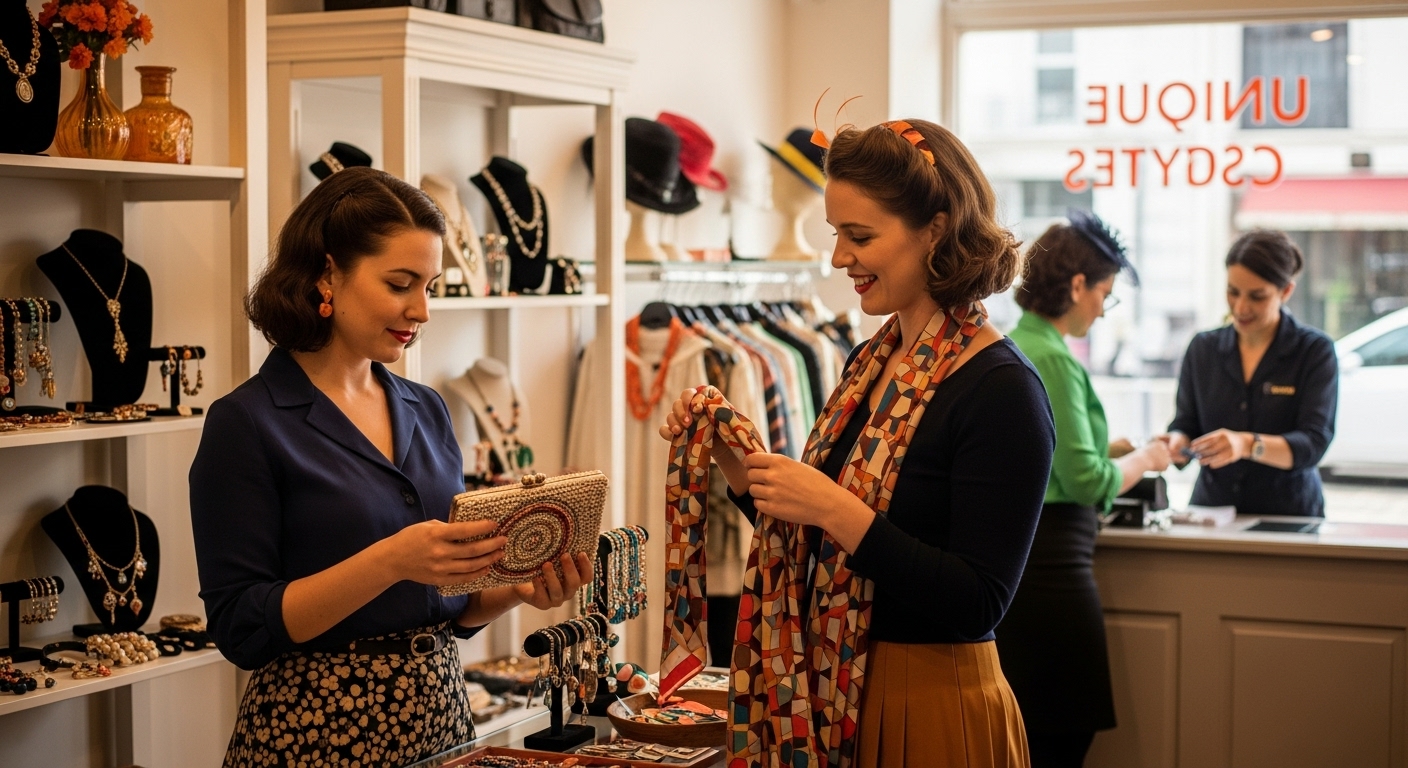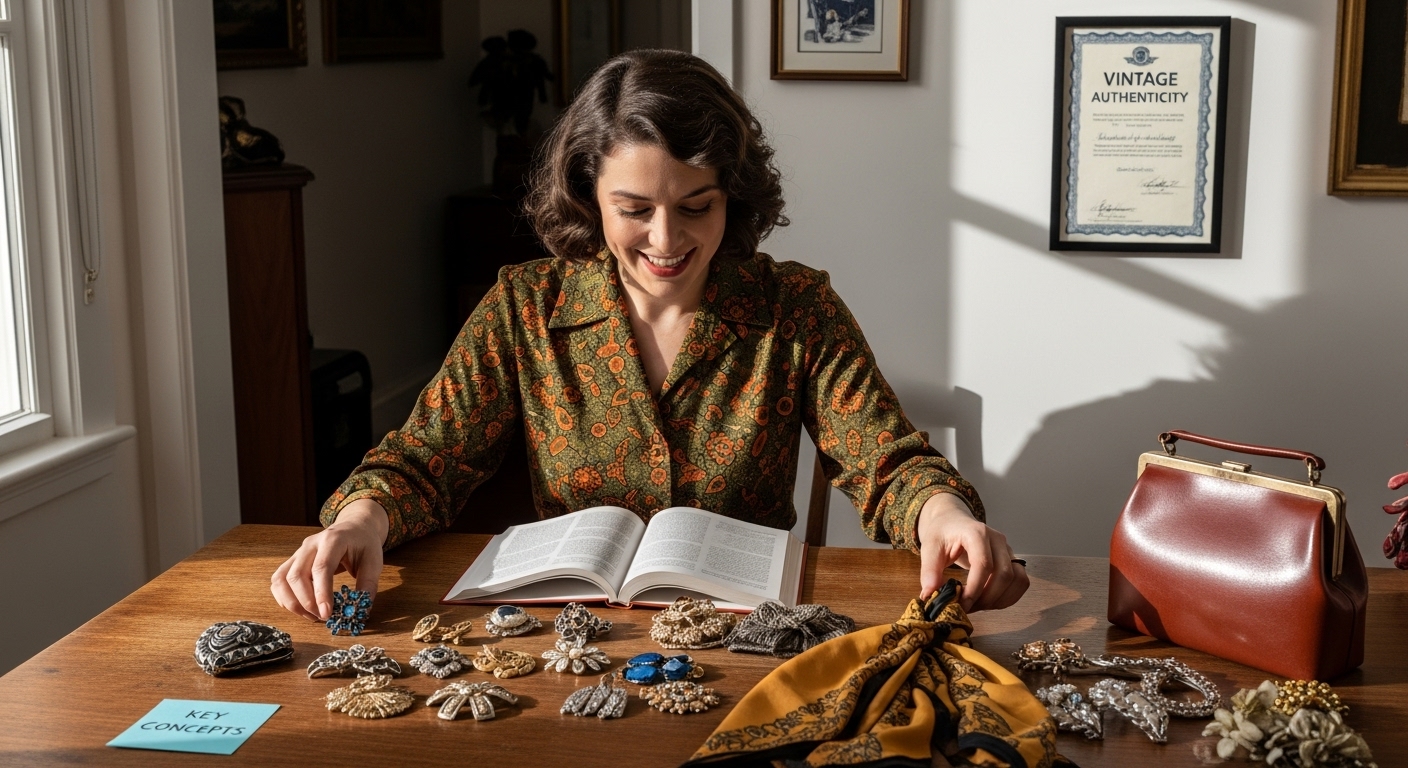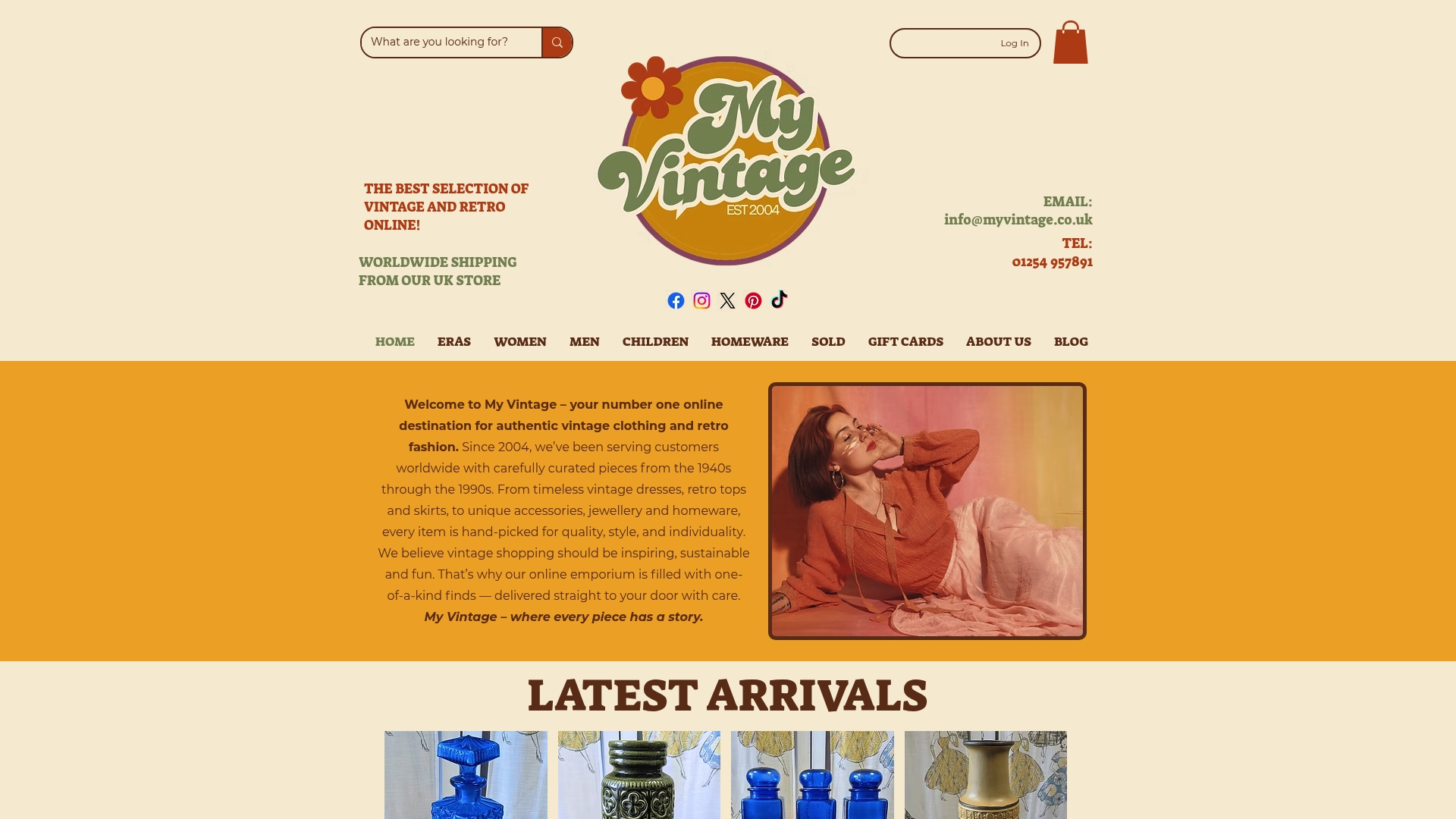Vintage Accessories Explained: Discover Unique Styles
- Emma

- Oct 1
- 8 min read

Vintage accessories carry a timeless allure that modern fashion can seldom match. More than 60 years after their creation, many vintage pieces are still worn daily thanks to their superior craftsmanship and resilient materials. These items are not just relics of the past. While they might look like simple embellishments at first glance, the real surprise is their immense cultural and historical influence on today’s trends. Each accessory acts as a bridge that connects decades of design, identity, and innovation with the present moment.
Table of Contents
Quick Summary
Takeaway | Explanation |
Vintage accessories represent historical craftsmanship. | These items reflect unique manufacturing techniques that prioritize durability and detail over modern mass production. |
They serve as cultural and social artifacts. | Vintage accessories embody historical narratives that express economic conditions and social movements from their era. |
Choosing vintage supports sustainable fashion. | Opting for vintage allows for resource conservation, reducing waste by extending the lifecycle of fashion items. |
Authenticity is crucial in vintage selection. | Recognizing craftsmanship markers and provenance helps verify the authenticity of vintage accessories. |
Vintage influences modern fashion trends. | Designers draw from vintage styles to innovate, reviving historical elements in contemporary fashion. |
What Are Vintage Accessories and Their Characteristics?
Vintage accessories are distinctive fashion items originating from past decades, typically spanning the 1920s to the 1980s. These unique pieces represent more than mere embellishments - they are tangible connections to historical fashion movements, cultural expressions, and craftsmanship that transcend contemporary mass-produced designs.
Defining Characteristics of Vintage Accessories
Authentic vintage accessories possess several distinguishing features that set them apart from modern equivalents. Material quality stands out as a primary indicator, with vintage pieces often showcasing superior craftsmanship and more durable construction techniques. Unlike contemporary mass-produced items, vintage accessories were frequently handmade or manufactured using specialised techniques that prioritised longevity and intricate detailing.
Key characteristics include:
To aid understanding of what sets authentic vintage accessories apart, the following table summarises their key defining characteristics and how these contrast with modern equivalents.
Characteristic | Vintage Accessories | Modern Accessories |
Material Quality | Superior, often more durable materials | Often mass-produced, lower-cost materials |
Craftsmanship | Handmade or produced with specialised techniques | Predominantly machine-made |
Design Elements | Unique, historically reflective details | Frequently trend-driven, less distinctive |
Production Scale | Limited production runs, greater rarity | Mass-produced, widely available |
Longevity | Crafted for lasting durability | Usually designed for short-term wear |
Value | Potential to appreciate over time | Value typically decreases quickly |
Unique design elements reflecting specific historical periods
Exceptional material quality compared to modern reproductions
Handcrafted details and intricate manufacturing techniques
Limited production runs making each piece potentially rare
Historical and Cultural Significance
Vintage accessories are not merely decorative objects but powerful storytellers of social history. According to the Victoria and Albert Museum’s collection, each accessory represents a snapshot of design evolution, technological innovation, and cultural aesthetics of its era. A 1926 forest-green leather handbag with a Bakelite handle, for instance, reveals more than just fashion trends - it demonstrates the technological advancements and design philosophies of the interwar period.
For those eager to explore more about these fascinating fashion artifacts, read our comprehensive guide on vintage accessory styles. Whether you are a seasoned collector or a curious fashion enthusiast, understanding vintage accessories offers a fascinating journey through design, craftsmanship, and cultural expression.
The Cultural Significance of Vintage Accessories
Vintage accessories transcend mere fashion statements, serving as powerful cultural artifacts that encapsulate social narratives, technological innovations, and personal identities. These intricate pieces represent more than aesthetic choices - they are tangible historical documents revealing complex societal transformations across different eras.
Storytelling Through Design
Each vintage accessory carries an embedded narrative about its historical context. Design elements reflect not just aesthetic preferences but profound social dynamics, economic conditions, and technological capabilities of their respective periods. A 1950s beaded clutch, for instance, might symbolise post-war economic recovery and emerging female independence, while an Art Deco brooch could represent the avant-garde artistic movements of the interwar period.
Key cultural narrative elements include:
Representation of social movements and gender dynamics
Technological innovations reflected in manufacturing techniques
Economic conditions impacting design and material choices
Personal and collective identity expressions
Societal Reflections and Identity
Research from Heriot-Watt University highlights how vintage accessories serve as complex identity markers. They are not simply decorative items but intricate communication tools through which individuals express individuality, cultural belonging, and personal histories. A carefully curated vintage accessory collection can reveal profound insights into personal taste, historical awareness, and social positioning.
For enthusiasts wanting to dive deeper into the world of vintage style, explore our comprehensive guide on retro accessories that unravels the nuanced stories behind these captivating historical artefacts. Understanding vintage accessories means engaging with a rich tapestry of social history, personal expression, and cultural evolution.
Sustainable Fashion: Why Vintage Accessories Matter
Vintage accessories represent far more than nostalgic fashion choices - they are critical components of a sustainable wardrobe, challenging the contemporary fast fashion paradigm through ethical consumption, reduced environmental impact, and preservation of craftsmanship. By choosing vintage, consumers make profound statements about resource conservation and responsible fashion practices.
Environmental Impact and Resource Conservation
Circular fashion principles are fundamentally embodied in vintage accessories. Unlike mass-produced contemporary items, these pieces eliminate the need for new manufacturing processes, reducing carbon emissions, water consumption, and textile waste. Each vintage accessory represents a form of recycling that extends an item’s lifecycle, preventing unnecessary resource expenditure and environmental degradation.
Key sustainable attributes include:
Zero additional manufacturing energy required
Elimination of new material production
Reduction of textile waste in landfills
Preservation of historical craftsmanship techniques
Economic and Ethical Consumption
According to the UK Government’s Sustainable Clothing Action Plan, sustainable fashion practices are crucial for reducing environmental impacts. Vintage accessories epitomise this ethos by offering consumers alternatives to disposable fashion trends. They represent intelligent consumption - pieces that transcend seasonal limitations, maintain intrinsic value, and often appreciate in worth over time.

For fashion enthusiasts seeking deeper insights into sustainable wardrobe strategies, explore our comprehensive guide on vintage clothing sustainability. By understanding the profound environmental and social implications of vintage accessories, consumers can transform their approach to fashion from mere consumption to meaningful, responsible selection.
Identifying Genuine Vintage Accessories: Key Concepts
Authenticity is paramount in the world of vintage accessories, requiring a sophisticated understanding of historical design, manufacturing techniques, and material characteristics. Discerning genuine vintage pieces demands keen observation, comprehensive knowledge, and a nuanced approach to historical fashion artefacts.
Material and Manufacturing Evidence
Craftsmanship indicators play a crucial role in determining vintage authenticity. Genuine vintage accessories exhibit distinctive manufacturing characteristics that modern reproductions cannot easily replicate. These include specific stitching techniques, unique material compositions, and construction methods that reflect the technological capabilities of their respective historical periods.
Key authentication markers include:
Hand-stitched details with irregular, non-machine-like precision
Materials consistent with historical manufacturing standards
Distinctive manufacturing marks or hallmarks
Wear patterns consistent with age and historical usage
Provenance and Historical Documentation
According to the British Hallmarking Council, official hallmarks provide critical evidence of an item’s authenticity and origin. Provenance documentation becomes essential in verifying vintage accessories, with factors such as original packaging, historical receipts, and expert certifications serving as crucial authentication tools.
For enthusiasts looking to expand their knowledge of vintage style selection, explore our curated guide on vintage accessory ideas that offers additional insights into identifying and appreciating these remarkable historical fashion pieces. Understanding the intricate details of vintage authentication transforms mere collection into a sophisticated exploration of fashion history.
To clarify the main authentication markers for vintage accessories mentioned in the article, the table below organises these features and what they typically indicate for collectors and enthusiasts.
Authentication Marker | Description | What It Indicates |
Hand-stitched Details | Irregular, non-machine-like stitching | Indicates handcrafted authenticity |
Material Consistency | Use of period-appropriate materials (e.g., Bakelite, old leathers) | Confirms era-accurate construction |
Manufacturing Marks/Hallmarks | Distinctive stamps, signatures, or hallmarks | Traces item origin and maker |
Historical Wear Patterns | Age-appropriate signs, e.g., patina, gentle ageing | Supports genuine use and age |
Provenance Documentation | Original packaging, certificates, or receipts | Substantiates authenticity and history |

How Vintage Accessories Influence Modern Trends
Vintage accessories serve as powerful catalysts in contemporary fashion, transcending mere nostalgic elements to become dynamic drivers of design innovation and creative expression. Far from being relics, these historical pieces continuously reshape modern aesthetic sensibilities, challenging conventional fashion narratives and inspiring designers across generations.
Reinterpretation and Design Evolution
Cyclical design principles demonstrate how vintage accessories fundamentally influence contemporary fashion trends. Designers frequently draw inspiration from historical craftsmanship, reinterpreting classic silhouettes, materials, and decorative techniques. A mid-century brooch might inspire intricate modern jewellery design, while a 1920s beaded clutch could inform current handbag architectural structures.
Key contemporary design influences include:
Reviving historical manufacturing techniques
Reimagining historical colour palettes and material combinations
Incorporating traditional craftsmanship into modern design language
Challenging mass-production aesthetic standards
Cultural and Sustainable Fashion Movements
Research by Cassidy and Bennett at the University of Huddersfield reveals how vintage accessories drive contemporary fashion beyond aesthetic considerations. They represent critical expressions of individual identity, sustainability consciousness, and resistance to fast-fashion homogeneity.
Modern consumers increasingly seek unique, historically informed pieces that communicate personal narratives and environmental awareness.
For fashion enthusiasts eager to explore the intricate world of vintage style influences, discover our curated guide on understanding vintage’s role in contemporary fashion. By appreciating vintage accessories, we participate in a rich, ongoing dialogue between historical craftsmanship and innovative design perspectives.
Find Your Story in Every Vintage Accessory
Searching for accessories with real history often feels overwhelming. The article explored how authentic vintage accessories capture moments of culture and craftsmanship that fast fashion cannot replicate. At My Vintage, you never need to worry about missing out on one-of-a-kind pieces or feeling unsure about what truly is vintage. Each accessory has been carefully chosen for its unique design, exceptional quality and meaningful provenance. Discover the collection where every item tells a story and supports a more sustainable wardrobe.

Are you ready to bring genuine vintage character into your style? Visit My Vintage to browse the full range of accessories and clothing. Let us help you make your look stand out with pieces that matter. Start exploring now and take home a slice of history.
Frequently Asked Questions
What are vintage accessories?
Vintage accessories are distinctive fashion items from past decades, typically spanning the 1920s to the 1980s, that reflect historical fashion movements and cultures while showcasing superior craftsmanship.
How can I identify genuine vintage accessories?
To identify genuine vintage accessories, look for specific craftsmanship indicators, such as hand-stitched details, materials consistent with historical standards, distinctive manufacturing marks, and wear patterns indicative of age.
What makes vintage accessories sustainable?
Vintage accessories are considered sustainable because they eliminate the need for new manufacturing, reducing carbon emissions and waste. Choosing vintage is an example of ethical consumption, preserving craftsmanship and extending the lifecycle of items.
How do vintage accessories influence modern fashion trends?
Vintage accessories influence modern fashion by inspiring contemporary designers to reinterpret classic designs, materials, and techniques, leading to innovative aesthetics and sustainable fashion movements.
Recommended








Comments